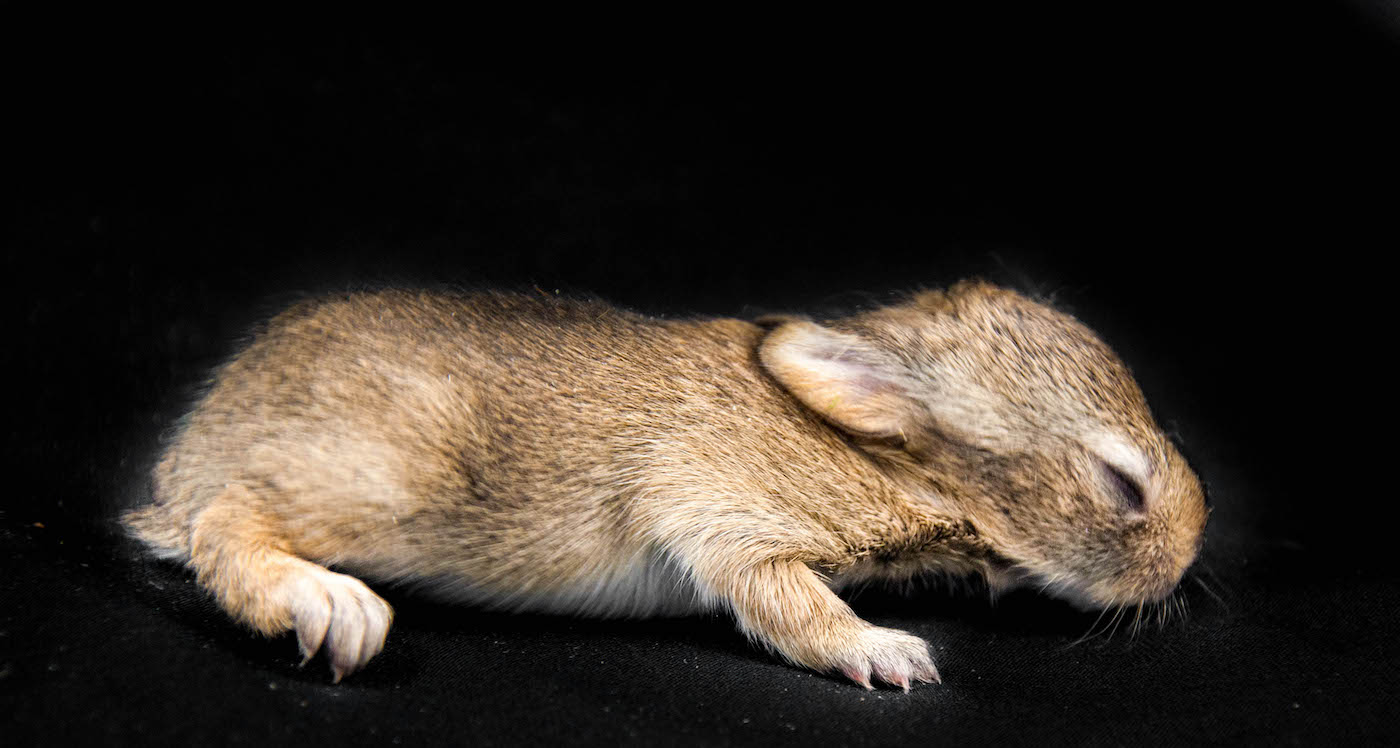The Brush Rabbits

The Santa Barbara Wildlife Care Network (SBWCN) just released its first baby animal intakes for 2018. Two juvenile brush rabbits, one weighing 76 grams during intake and its sibling weighing 78 grams, were discovered by a community member’s dog and subsequently removed from their nesting den in Santa Barbara. The individual concerned about their well-being called SBWCN for advice and brought the two baby rabbits to the center for further care. Judging by their weight, it is estimated that the two rabbits were around 2 weeks of age.
Brush rabbits are extremely common to Santa Barbara and our native chaparral landscape. Interestingly, this species does not create its own dens for nesting, but alternatively, utilize pre-made dens from other animals. Although they breed throughout the year, the peak breeding season tends to begin in early February and continues throughout the remainder of spring and summer well into August. With a short gestation period of only 22 days, female brush rabbits can rear as many as five litters during one year. Babies will stay with the mother in her nest for a total of five weeks before leaving to explore the world on their own.
Keeping Them Stable
When Santa Barbara Wildlife Care Network first receives a juvenile brush rabbit, stabilization of the animal is extremely important and occurs prior to providing further treatment or care. In general, wild rabbits are notoriously difficult animals to rehabilitate. This species is prone to elevated levels of stress during care, a risk factor that can seriously harm or even kill an animal. When an initial exam is performed to assess the reason for admission, handling of the brush rabbit must be kept to a minimum to limit the risk of injury.
Upon examination, the smaller 76-gram rabbit was found to have a puncture wound and, accordingly, was placed on an antibiotic mixture of trimethoprim-sulfonamide (TMS). This drug combination is preferred for treating mammals at SBWCN in place of other antibiotics that have been shown to interfere with the growth of cartilage surrounding long bones in developing animals.
Formula Feeding
Once the two rabbits were stabilized at the center, they were placed in a warm, dark, quiet environment. Often a large Rubbermaid container is used with a grass hay substrate placed on top of a heating pad. The first few days were trying for these two, and there was difficulty in getting the smaller rabbit to eat. Conditions have to be perfect when feeding these particular animals. The formula must be warm, even hot to the touch, and most baby rabbits will be fed with their eyes covered by a cloth to reduce stress.
The two rabbits were fed via a 1cc syringe containing a specialized formula specifically designed for juvenile brush rabbits. This formula is initially started at a 25-percent concentration with water and gradually increased during the rabbit’s stay. The gradual increase ensures that the animal will be able to properly digest any nutrition that it is receiving. Over the course of a rabbit’s recovery at SBWCN, they will be raised to a 100 percent concentrated formula while they are still being syringe-fed.
Before each feeding, rabbits are weighed and calculated a given feeding amount based on 10 percent of their body weight. This ratio limits the risk of bloat, a condition that can prove to be potentially fatal in rabbits. It is not well understood if bloat is primarily due to overeating, or possibly the result of a lack of beneficial bacteria within the rabbit’s GI tract. Some juvenile orphaned rabbits in care are also supplied with a probiotic, a healthy mixture of bacteria that will benefit the rabbits’ GI tract, similar to the way in which juvenile rabbits will ingest their mother’s cecotropes, special components of rabbit excrement that contain microbial proteins, B vitamins, and other essential nutrients.
Throughout the process of formula feeding, rabbits will still be presented with grass hay and buckwheat to pique interest in eating on their own. When a rabbit is finally weaned off of a liquid diet, it will be given an increasingly dilute formula mixture in a saucer while being given a primary diet of buckwheat, grass hay, and other grasses.
Free at Last
These rabbits were released in a residential area near the location in which they were found. While SBWCN releases animals within a mile of their address at discovery, it is also important to ensure safety of the animal with a reduced risk of potential predators. In 2017 alone, 19 brush rabbits were brought to SBWCN after dog attacks. For cats, the intake number for brush rabbits in 2017 alone was a whopping 70. Spring and summer are the most vulnerable seasons for many wildlife species, and in many cases, the best ways to protect wildlife are to keep pets indoors unless monitored during nesting and breeding seasons.





